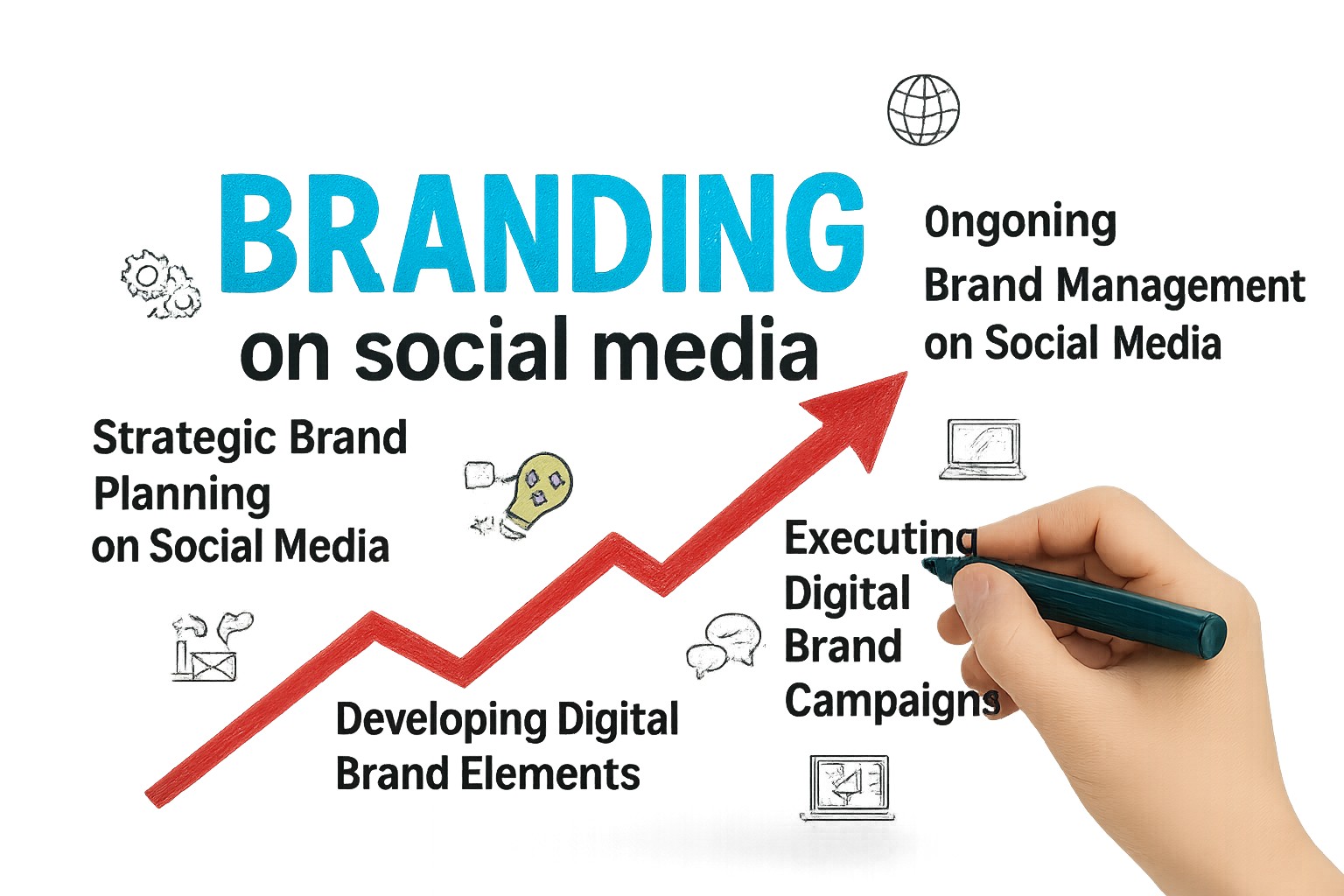Article Overview:
Introduction
How to Build a Professional Brand for Service-Based Businesses on Social Media? Did you know that over 85% of service customers form their perception of your brand through social media even before they ever visit your website?
In today’s world, professional branding in social media is not just an option for service-based businesses; it’s a vital necessity for growth, trust-building, and survival in the digital space.
Yet, many service businesses approach their brand not with a clear brand strategy, but in a scattered, emotional, or reactive way. The result? An unclear brand image in the minds of your audience, confusion, lack of trust, and missed opportunities for growth.
For businesses that don’t offer physical products-like agencies, consulting firms, training centers, clinics, or even B2B service providers-your brand is the digital experience your audience receives from interacting with you on social media.
But the key question is:
How can you build a service brand that is not only seen on social media, but also trusted and remembered?
In this article, based on a 7-step branding model-the result of meta-synthesis research and interviews by the Bazarento team with digital branding experts-we outline a practical, data-driven, and actionable roadmap for digital branding in the service sector. This model is both grounded in analysis and designed for real-world implementation in small and medium-sized businesses.
If you want to transform your brand from just another online page into a trusted and memorable name in your audience’s mind, this service branding guide for the online space is for you!
The 7-Step Branding Model for Service-Based Businesses on Social Media
In this section, based on research conducted by the Bazarento team, the 7-step branding model for social media guides service-based businesses through each stage-from context analysis to brand institutionalization-step by step:
Professional branding in social media must begin, even before logo design or content creation, with a key question: Are your external and internal conditions ready for building a digital service brand?
In the 7-step branding model, “context analysis” means identifying both macro and micro factors that influence how your audience perceives your brand.
Think of context analysis as preparing the soil before planting the brand tree.
1. External Context (External Environment)
According to research findings, a brand’s success or failure on social media largely depends on the broader environment, including:
- Economic conditions and public trust in online services
- The media culture and social media usage patterns of your target audience
- Internet speed, access to technology, and the popularity of different platforms
- Content policies and platform algorithms-whether restrictive or supportive
- The maturity level of the service industry in the digital space
📌 While these factors are outside your control, they must be considered in your brand strategy-just like checking the weather before planting seeds.
2. Internal Context (Immediate Environment)
Alongside external factors, what happens inside your brand and team is just as crucial. Internal context includes:
- The clarity of your digital brand’s vision and mission
- The mental readiness of you and your colleagues to build a purposeful brand
- The cohesion of internal communications and your style of audience interaction
- Use of digital marketing tools and data-driven decision-making
- Attention to customer experience at every online touchpoint
📌 A digital brand is not just a beautiful storefront; it’s a reflection of your business’s values, mindset, and behaviors-even if you’re a solo entrepreneur.
Is your brand’s soil ready for planting?
This stage is all about answering two fundamental questions that will determine your brand’s future in the digital space:
- Is your target audience, in the external environment, ready to hear your brand’s message?
- And within your business, do you have the mental, cultural, and communication capacity needed to build a digital service brand?
📌 If your answers are clear and realistic, you can be confident that your brand is being planted in soil that’s ready for growth.

If your brand’s “soil” was prepared in Step One, it’s now time to gather the seeds, tools, and resources that will help your brand grow across social media.
In this study, we demonstrate that the resources required for professional branding in social media can be categorized into five main groups.
1. Structural Resources
For any service-based business, large or small, it’s crucial to define a clear structure and pathway for digital activity. This structure may include:
- A dedicated person or team to manage your social media presence
- Clear division of roles within the team (such as content creation, engagement, design)
- Or even collaboration with freelancers and external support agencies
A defined structure ensures that branding efforts are organized, consistent, and scalable-key for building trust and recognition in the digital space
2. Strategic Resources (Brand Mindset and Beliefs)
The most successful digital brands are led by individuals who truly believe in digital marketing and approach their online presence strategically-not just as a side activity. If you’re a business owner or leading a small team, you should:
- Deeply understand your target audience
- Clearly define your brand message
- Approach online interactions with motivation, active listening, and a long-term vision
A strategic mindset is essential for creating a brand that stands out and builds lasting relationships with its audience
3. Financial Resources
Digital branding is not possible without a financial investment-even for startups or home-based brands. Typical expenses include:
- Targeted advertising on platforms like Instagram or Google
- Professional content design
- Subscriptions for analytics and content scheduling tools
All of these are investments that pay off in brand awareness, higher engagement, and improved conversion rates
4. Human Resources (Team or Brand Partners)
Successful businesses have teams that:
- Are familiar with digital branding concepts
- Operate in alignment with the brand message
- Demonstrate creativity, a learning mindset, and commitment
Whether you work as a team or solo, ensure your brand perspective is reflected in all activities
5. Technological Resources (Tool Infrastructure)
Social media is powered by tools. The right tools can streamline your brand’s journey:
- Content management apps (like Canva, Buffer, Notion)
- CRM systems, messaging automation, or even a simple Excel sheet for tracking feedback
- User experience design for landing pages, booking, sales, or support
Digital tools and platforms are the backbone of efficient, data-driven branding efforts

At this stage, the branding process on social media is structured into five interconnected and complementary components:
1. Strategic Brand Planning on Social Media
This stage consists of two levels:
- Strategic Planning
Define your brand’s high-level goals, identify your target audience, craft your value proposition, and position your brand uniquely within social media channels. - Tactical Planning
Decide on the types of content you will create, develop a content calendar, establish communication formats, and set clear brand messaging guidelines.
These two planning levels are only effective when aligned and mutually reinforcing.
2. Developing Digital Brand Elements
After setting your strategy, you must develop and refine your brand’s digital assets, including:
- Designing visual brand elements (color palette, logo, fonts, post styles)
- Defining the brand’s tone of voice (friendly, professional, educational, etc.)
- Creating brand guidelines for consistent use across all channels
In simple terms, this means ensuring your brand’s appearance, tone, and messaging are coordinated at every audience touchpoint.
3. Executing Digital Campaigns
Your brand must be seen and understood by your audience. Use digital campaigns to communicate and reinforce your brand message:
- Brand awareness campaigns
- Engagement campaigns
- Targeted paid advertising campaigns
The goal is to strengthen brand perception, increase recall, and shape a distinct digital brand identity in your audience’s mind.
4. Ongoing Brand Management on Social Media
Once the seeds are planted, it’s time to nurture continuous brand growth. Ongoing execution means keeping your brand alive in your audience’s mind-not just by posting, but by building real connections. Key actions include:
- Keeping all communication channels active (Instagram, website, Telegram, or wherever your audience is)
- Consistently engaging with your audience (replying to comments, asking questions, running polls or interactive stories)
- Monitoring competitors (analyzing their content, engagement tactics, and strengths)
- Tracking audience reactions (likes, comments, shares, saves)
Metrics like reach, impressions, and engagement rate show how visible your brand is and how well your audience is connecting with it.

Mechanisms for Brand Longevity in the Audience’s Mind
At this stage of the 7-step branding model, your brand moves from the “execution” phase to the phase of “sustainability and depth.”
To ensure your brand-especially as a service-based business-remains memorable, is repeated, and builds trust in the minds of your audience, you must use mechanisms that reinforce the foundation for sustainable growth.
1. Core Mechanisms
These mechanisms are the pillars of audience trust and the formation of a strong brand identity:
- Interactive Content Marketing:
Foster two-way communication with your audience using tools like stickers, polls, and rapid responses. Interactive content increases engagement, encourages participation, and helps your brand stay top-of-mind - Targeted Content Marketing:
Share relevant and valuable content that directly addresses the real needs of your users. Content should be tailored based on data-driven insights and audience segmentation to maximize impact and build authority - Creating a Positive Customer Experience:
Ensure a seamless and positive experience at every touchpoint-from initial contact to post-purchase support. A positive experience is the foundation for trust and brand advocacy - Building Brand Communities:
Cultivate a sense of belonging by inviting users to participate and create content (user-generated content). Encourage community through branded hashtags and collaborative campaigns to boost engagement and loyalty
2. Supporting Mechanisms
Alongside the core mechanisms, several complementary factors can further strengthen your branding efforts:
- Integrating Online and Offline Presence:
Combine your digital and physical brand activities to create synergy and deepen emotional connections with your audience - Event Marketing:
Host online or offline events (such as webinars, live streams, or workshops) to foster emotional bonds and increase audience interaction with your brand - Learning from Successful Brands:
Analyze and draw inspiration from brands that resonate with your target audience. Benchmarking helps refine your strategy and content approach - Unified Presence Across Channels:
Maintain consistent messaging and visual identity across all platforms-Instagram, website, Telegram, YouTube, and more-to present a cohesive and professional brand image

Now it’s time to see what has sprouted from the seeds you planted-what results have you harvested?
At this stage of the 7-step social media branding model, you evaluate the real outcomes and impacts of your brand, both for your audience and your service-based business.
Branding Outputs Occur on Three Levels:
1. Brand Level
- Increased brand awareness and perception
- Strengthened brand identity
- Enhanced brand positioning within the digital space
2. Audience Level
- Improved audience trust and confidence in the brand
- Better overall brand experience
- Development of audience loyalty and advocacy
1. Brand Level
- Higher engagement rates on social media content
- Reduced customer acquisition costs
- Establishment of a lasting brand presence in the target market’s mind
This stage shows how fruitful your efforts have been and what is ready for harvest
This stage is the time to examine the sprouts. Here, you need to take a closer look at your brand:
Have the sprouts grown in the right direction? Which branches of the brand have become stronger? What needs to be pruned?
This stage is about the continuous measurement of brand performance on social media. The key performance indicators (KPIs) for digital branding include:
- Evaluating brand positioning relative to competitors
- Analyzing audience feedback on content
- Conversion rate, engagement rate, and loyalty rate
By tracking these KPIs, you can assess the health and effectiveness of your brand, identify strengths and weaknesses, and optimize your strategy for better results.
From Sprout to Tree; From Brand to Culture
In the final stage of the 7-step branding model, the focus is on transforming the brand from a project into a living culture within your organization or team.
If your service-based business has so far viewed branding merely as an appearance or campaign, now is the time to:
- Ensure brand identity is present in all behaviors and digital interactions.
- Make brand values an inseparable part of decision-making.
- Keep content, messaging, and brand imagery consistent across all channels (Instagram, website, email, etc.).
- Document successful processes and provide training for teams.
Conclusion
From Seed to Enduring Brand (What We Learned!)
Branding on social media for service-based businesses is no longer a choice-it is a necessity for visibility, trust-building, and sustainable growth. Without a clear roadmap, your brand may fade from the audience’s mind or be misinterpreted.
In this article, by reviewing the professional 7-step branding model, we learned that a successful service brand starts with a precise understanding of the platform, the right resources, and the execution of branding processes. It continues with mechanisms such as interaction, content creation, and delivering a positive experience.
Brands that continuously evaluate their performance, gather feedback, and improve the customer experience build a strong brand identity, positive perception, and lasting loyalty in the minds of their customers.
Article writer

Mehrnoosh Choobandian
Director of Bazarento
Ph.D. in Marketing
Marketing & Branding Strategist
Ready to turn your service brand into a trusted, high-impact presence on social media
refine your brand voice, our expert team is here to support you every step of the way. From targeted digital marketing to customized branding solutions, we help service professionals like you grow with clarity, consistency, and confidence



